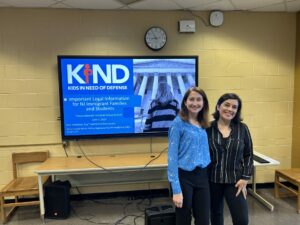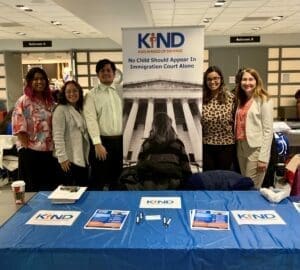From the Field
 It is back-to-school season in the United States. Children across the country are buying notebooks and pencils, preparing their clothes or uniforms, and eagerly anticipating (or dreading) the first day of school. This can be a particularly stressful time for children entering a new school. But imagine how overwhelming it can be for an unaccompanied child who recently entered the United States, knows little or no English, and has no understanding of the U.S. school system and their place within it.
It is back-to-school season in the United States. Children across the country are buying notebooks and pencils, preparing their clothes or uniforms, and eagerly anticipating (or dreading) the first day of school. This can be a particularly stressful time for children entering a new school. But imagine how overwhelming it can be for an unaccompanied child who recently entered the United States, knows little or no English, and has no understanding of the U.S. school system and their place within it.
As an Equal Justice Works Fellow sponsored by Microsoft and Sidley Austin LLP, I have been working this past year with K-12 school districts throughout New Jersey to help educators understand who unaccompanied children are, the common barriers they face when trying to access K-12 education and services, and the forms of legal immigration status they may be eligible for or may be pursuing.
Sixteen-year-old Rolando* is one of these children. He fled abuse by his father in Guatemala and was released to his mother in New Jersey after a traumatic journey alone through Mexico. When he went to enroll in school, the school district saw that Rolando had missed four years of formal education and placed him in an alternative high school for older children, many with criminal backgrounds. Rolando did not feel safe at the school and was afraid to go in each day. With help from his KIND attorney, Rolando was transferred to the district’s bilingual program in the traditional high school. He was excited to attend ninth grade in the new school, but nervous that he was far behind his peers and barely literate in his native Spanish. Luckily, his district has a bilingual program designed for students with interrupted education, including educators trained in how to help students like Rolando catch up.
Rolando’s challenges are not unique. Many KIND clients come to the United States with interrupted formal education and are academically years behind their peers. A number don’t speak English and may be entering a school system with limited bilingual or English Language Learner programs. Some clients may be only partially literate in their native language. Not all school districts have programs to assist children with these challenges.
 Clients can also have undiagnosed learning disabilities. Or, alternatively, schools may mistakenly classify clients as needing special education because the school was unable to properly assess them in their native language.
Clients can also have undiagnosed learning disabilities. Or, alternatively, schools may mistakenly classify clients as needing special education because the school was unable to properly assess them in their native language.
Sometimes, clients are academically successful, but are failed by the school district because they aren’t considered for higher level or college prep classes. Counselors might not give them information about the college application process because of their language differences or they mistakenly believe the students are not interested in higher education.
Sponsors and parents of clients may struggle to understand the school system and how their children are progressing as many school districts fail to provide information in a language they understand. And none of these challenges even begin to address the social, emotional, and even traumatic experiences our clients have gone through and are still processing.
Yet, despite all these challenges, our clients also positively contribute to and strengthen the learning environment in our schools through their multilingualism, lived experiences, and, in many cases, a deep commitment to pursuing their education.
As I travel around the state to share information with school systems, from large urban districts to small suburban ones, educators react in a variety of ways: from shock learning about the experiences their students have survived, empathy and a desire to better support their students, or a realization that their district has to work harder to reduce the barriers to success for unaccompanied and other immigrant children in their districts.
Now, as school gets underway in our communities, there are many ways that all of us can help unaccompanied children and other newcomers as they adjust to the new school experience:
- If you are an educator, provide an empathetic space for your students and work with the English services team at your school to provide the support your students need to succeed.
- If you are an administrator, review and update your district’s policies on residency verification, vaccinations, language access for parents, language learning for students, and special education services to make sure unaccompanied children have access to the services they need to be successful.
- Educators and administrators should also consider checking out the U.S. Department of Education’s Newcomer Toolkit for ideas on what your district can do to help. Consider making your district a model for newcomers by joining the National Newcomers Network. If nothing else, make sure your district is following federal laws about educational access for your students.
- Not an educator or administrator? You can still help! If you are a parent or have other young people in your life, encourage them to befriend the new kids in class. Befriend the new parents, and model to your children what being a welcoming community looks like. And if you don’t have children in the school system but want to be an ally, support newcomers in your neighborhood or contact your local school district to see if there are ways you can volunteer and help.
You can also read KIND’s fact sheet, How to Support Unaccompanied Immigrant Children and Youth in U.S. Schools.
Together, we can make this school year more inclusive and a little less daunting for all new students, especially unaccompanied children like Rolando.
